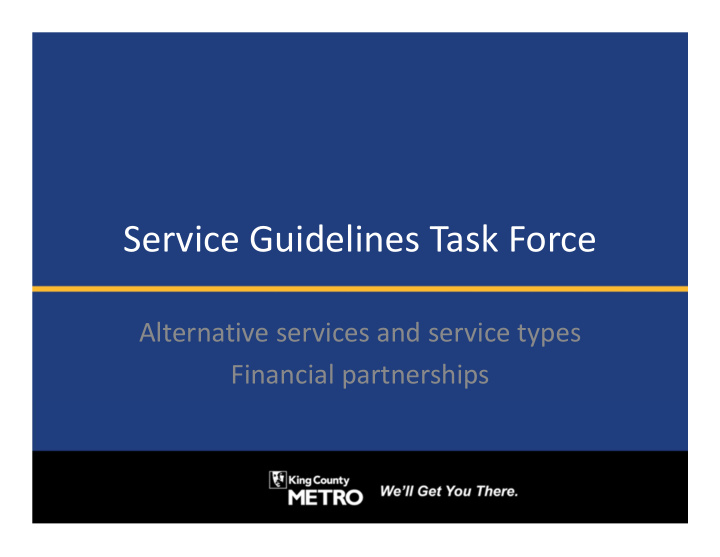



Service Guidelines Task Force Alternative services and service types Financial partnerships
First round of service reductions focused on Alternative Services have evolved over time lowest performing service Flexible Community Community Existing Rideshare Hub Alternative Shuttle Services Local transportation A route with flexible Variable ridesharing via center, access to service areas provided promotion of mobile and Build on these community vans, bikes and through a community web ‐ based app. successful services. information resources. partnership. VanShare partner provides responds to unique fixed and flexible VanPool location, service area commuter needs Rideshare transportation info community partner may include set pick ‐ up CAT and scheduling provides resources points and driver DART regularly scheduled incentives and marketing and one ‐ time trips 2 Service Guidelines Task Force
Metro has increased focus on alternative services as a way of providing mobility options Expanding program: $12 million / 2 ‐ years Mitigate impacts of service cuts Complete 2012 Plan Complementary areas Focus on community partnerships Demonstration projects 3 Service Guidelines Task Force
First round of service reductions focused on There are over 20 current or planned alternative services throughout King County lowest performing service DART Flexible Flexible • Rideshare service area & 14 routes in • Community King County Hubs Planned Community Services Shuttle Southeast • • Flexible King County service area • Vashon Community • Island partnerships 4 Service Guidelines Task Force
Is this the right approach to alternative services? Metro implements Alternative Services: Where fixed ‐ route mobility does not work To replace lower ‐ performing, less used fixed ‐ route services To seed new markets To test new concepts 5 Service Guidelines Task Force
Service Guidelines Task Force Service types
Changes to service types would value different kinds ypes of service Current service types Possible changes to service types • Two primary service • New service types to value Description types Peak ‐ Only routes • Preserves service within • Revised service type to two different markets value community shuttles with variable routing Service Types • Seattle core • Seattle core • Non ‐ Seattle core • Non ‐ Seattle core • Demand Response • Express 7 Service Guidelines Task Force
How would performance change if Metro added Express and Demand Response service types? Impacts 18 18 18 Establishes different • Seattle Core Seattle Core 16 Express performance thresholds for 16 16 Seattle Core (59 routes) (119 routes) (71 routes) like services Express Passenger Miles / Platform Mile Passenger Miles / Platform Mile Passenger Miles / Platform Mile 14 14 14 • Values different kinds of Seattle Core System Average: 12.3 services, based on mobility System Average: 12.3 System Average: 12.3 12 12 12 needs throughout the county Would limit cuts to Express • 10 10 10 Non ‐ and DART routes Non ‐ Seattle Seattle • \ Non ‐ Seattle Core 8 8 8 Core Trade ‐ offs Non ‐ Seattle Core System Average: 36.3 System Average: 36.3 (67 routes) System Average: 36.3 Core (43 routes) 6 6 6 Less focus on productivity • Systemwide cost per rider • Demand 4 4 4 would likely increase Response Demand • Some higher productivity Response 2 2 2 services would be identified (15 routes) for reduction Alternative Services Alternative Services (2 routes) 0 0 0 More potential candidates • 0 10 20 30 40 50 0 0 10 10 20 20 30 30 40 40 50 50 for reduction and investment Rides / Platform Hour Rides / Platform Hour Rides / Platform Hour 8 Service Guidelines Task Force
Adding these example service types would shift Metro’s service emphasis Existing Markets: New Markets: Providing more Building ridership service to current in emerging riders markets Productivity: Serving Coverage: the most dense, Serving all transit ‐ supportive parts of the areas of the county county Peak ‐ Only: Connecting lower All ‐ day: Connecting density areas to job centers centers throughout during busiest travel times in the county all ‐ day in one direction only both directions Non ‐ Transit Dependent Transit Dependent Riders: Providing service to Riders: Providing service those who have other to those with limited options mobility options Service Guidelines Task Force 9
Metro could consider other ways of modifying the guidelines in combination with changes to service types Implement minimum service levels Define different performance measures for different service types Expand the alternative services program Consider how performance is used to make reductions Add an investment priority targeted to peak ‐ only express service 10 Service Guidelines Task Force
Service Guidelines Task Force Financial partnerships
Metro’s financial partnerships Why does Metro have financial Example entities that Metro partnerships? partners with To leverage funds from Cities other sources to provide Private employers transit service Other transit providers To collaborate with Social service agencies municipalities and Public schools communities to better meet mobility needs To address gaps in service, service regional needs and provide specialized service 12 Service Guidelines Task Force
Is this the right approach to financial partnerships? Depending on the type and percentage of funding for a partnership, Metro may: Elevate identified investments in our service guidelines Make exceptions to the service guidelines when changing or reducing service Match partner’s financial contributions 13 Service Guidelines Task Force
Recommend
More recommend